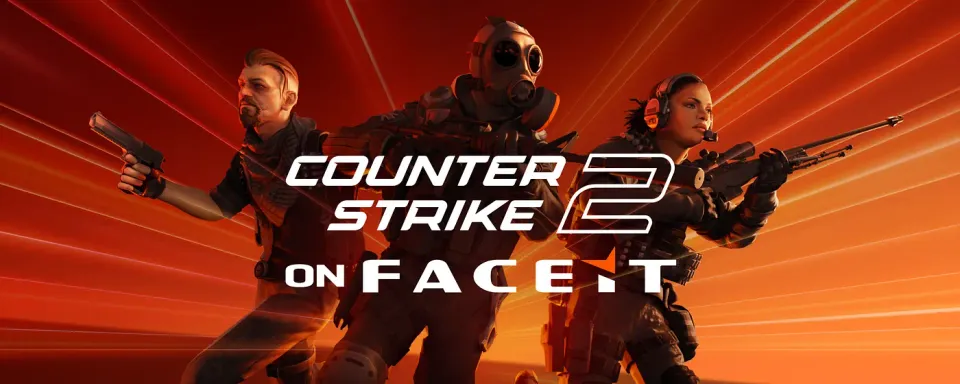Article
14:48, 10.03.2025

For many new CS2 players, the idea of switching from Valve’s Premier Mode to FACEIT can feel intimidating—everyone seems so skilled, and the ranking system looks complicated. In reality, it’s not as daunting as it appears. This guide provides a concise, no-nonsense breakdown of FACEIT ranks, how they work, and what they truly mean for your Counter-Strike 2 journey. Additionally, we’ll cover recent FACEIT 2.0 updates, which aim to improve the platform’s user experience, address smurfing, and refine matchmaking for the community.
FACEIT Ranks Explained
FACEIT uses a tiered ranking system (Levels 1–10) plus Challenger (Top 1,000 per region). Each level reflects a specific ELO range, indicating a player’s skill and match history. Here’s a quick breakdown:
- Level 1: 100–500 ELO
- Level 2: 501–750 ELO
- Level 3: 751–900 ELO
- Level 4: 901–1050 ELO
- Level 5: 1051–1200 ELO
- Level 6: 1201–1350 ELO
- Level 7: 1351–1530 ELO
- Level 8: 1531–1750 ELO
- Level 9: 1751–2000 ELO
- Level 10: 2001+ ELO
- Challenger: Top 1,000 in each region (EU, NA, SA, SEA, OCE)
ELO adjusts after each match based on your team’s win or loss and your personal performance. Typically, you gain or lose around 20–25 ELO per game, though it can vary depending on the skill difference between teams.

Where to See Your ELO
After signing in on the FACEIT website or app, go to the “Home” or “Stats” tab to find your current level and ELO rating. There, you can also review recent matches. For deeper analytics—like your K/D ratio and detailed performance metrics—third-party browser extensions (e.g., FACEIT Enhancer) or online trackers can provide extra data.
Faceit 2.0: Recent Changes
In November, FACEIT officially announced Faceit 2.0, an update designed to improve matchmaking quality, reduce toxicity, and introduce new features:
- Smurf Detection: Enhanced anti-cheat uses AI to detect suspicious secondary accounts. Offenders must prove their main account or face bans.
- Improved Premium Queue: Includes Veteran Matching, Votekick options, and a +30 Elo gain/loss for Premium Super Matches.
- Clubs Beta: Allows players to form mini-FPL style teams.
- Enhanced Stats: FACEIT Track BETA replaces older stats pages, giving deeper insight into player performance.
These changes aim to deliver fairer, more transparent competition, especially for newcomers who may have struggled with mismatched teams or smurf accounts.

How to Earn ELO Points
The ELO system is straightforward: you gain ELO for every win and lose ELO for every defeat. The amount typically ranges from ±20 to ±25, but can be higher if there’s a notable skill gap. Unlike some games, you cannot earn rating points through subscriptions or other means—only in-game performance counts.
Key Advice:
- Win Consistently: The simplest path to higher ranks is winning matches, obviously, but it’s about consistency and improvement, not just hours played.
- Team Up Wisely: FACEIT’s average ELO system can provide extra points if you beat higher-level opponents, but it also punishes you more if you lose.
Comparison: FACEIT vs. CS2 Premier Mode
Players often wonder how FACEIT ranks compare to Premier Mode in CS2. While no official equivalency exists, the consensus is that:
- Levels 1–3: ~0–4,999 Premier rating points
- Levels 4–6: ~5,000–9,999 points
- Levels 7–9: ~10,000–14,999 points
- Level 10: ~15,000–19,999 points, with further tiers up to 35,000+ for top players
Additionally, many pros and dedicated players still prefer FACEIT for its better anti-cheat, but the official Valve Premier Mode offers exclusive in-game tournaments and ranking systems. You might stick to Premier for official events or shift to FACEIT if you want stricter anti-cheat and more advanced matchmaking features.

Climbing the FACEIT Ladder
Rising through FACEIT levels can be challenging, especially if you’re used to CS2’s Premier Mode. Here are a few tips:

Essential Climbing Tips
- Master Utility: Smokes, flashes, and molotovs win more rounds than raw aim alone.
- Review Demos: Analyze your gameplay to spot mistakes and refine your strategy.
- Stay Calm: FACEIT can be stressful. Keeping a cool head helps you make better decisions.
Faceit 2.0 Enhancements
- Verified Matching: Encourages balanced matches with fewer smurfs.
- Votekick: A Premium-only feature that can remove toxic or inactive players.
- Party Finder: Helps you team up with players near your level.
Should You Switch to FACEIT?
If you’re fed up with VAC’s inconsistent anti-cheat or want more serious competition, FACEIT may be ideal. However, keep in mind:
- Valve Tournaments: Premier Mode is key for official Valve events.
- Faceit Anti-Cheat: Arguably more robust, giving you a fairer playing field.
- Community: Generally more competitive, with less casual chat and more focus on strategy.
Many high-level players see FACEIT as the pinnacle of third-party matchmaking. But if you’re a casual or still exploring Premier Mode, you might not need to jump ship yet.

Final Thoughts
Understanding FACEIT ranks in CS2 is crucial if you’re aiming for top-tier competitive play outside Valve’s official modes. Whether you’re climbing from Level 1 or pushing for Challenger rank, remember that consistent performance and teamwork matter most. With Faceit 2.0 bringing new features and better anti-cheat, the platform is even more appealing to players tired of cheaters or unbalanced matches.
In the end, the choice is yours. If you want a stable anti-cheat system, a transparent ranking approach, and robust competition, FACEIT might be your best bet. Just keep grinding, stay calm, and learn from every match—eventually, you’ll find your place among the higher levels. Good luck on your climb!







No comments yet! Be the first one to react